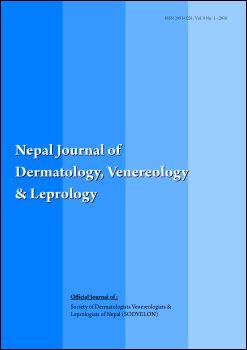Cutaneous manifestations in senile skin in coastal Goa
DOI:
https://doi.org/10.3126/njdvl.v9i1.5760Keywords:
Ageing, geriatric, dermatoses, intrinsic, chronological, biopsies.Abstract
Background Discoveries in medical sciences and improved social conditions during the past few decades have increased human life span thereby leading to an increasing segment of geriatric population.1 Senescence in the skin is a gradual process that ultimately results in the appearance and functional differences that we associate with age.2 The increasing segment of geriatric population are noted to have characteristic group of dermatoses which can be called as geriatric dermatoses. Such dermatoses may be expressed as cutaneous changes intrinsic to chronological ageing. Alternatively there may be other unrelated dermatoses having an altered expression on the geriatric skin.
Aims This study aims to delineate the spectrum of various geriatric dermatoses among the hospital population at Goa Medical College (GMC).
Methods This was a prospective study done over a period of one year in the department of dermatology, Goa Medical College. Patients above the age of 60 years presenting to the dermatological outpatient in GMC, patients referred from other wards were included in the study. A detail history and thorough clinical examination was done of every patient above 60 years who presented with skin complaints. A clinical photograph was taken of the relevant skin changes. Relevant investigations pertaining to the study were carried out to support the clinical findings.
Results Of the 411 geriatric patients above 60 years, males (64.7%) outnumbered females (35.3%). Age group of 65-69 years constituted a maximum (57.9%) number of geriatric patients. Amongst the geriatric dermatoses, wrinkling of skin (99.3%) and graying of hair (96.8%) outnumbered all other findings. This was followed by benign neoplasias (80.5%). Fungal infections (20.7%), eczemas (19.2%), papulosquamous disorders (12.3%), senile pruritus (9.2%), senile comedones (8.5%), fissured soles (6.8%), xerosis and leg ulcers (6.6%) each, pigmentory disorders (5.8%), infestation (4.9%), vesiculobullous disorders (4.4%), senile purpura and immune, rheumatic disorders (4.1%) each. 3 (0.7%) malignant cases were reported. Graying of hair (96.8%) and alopecia (32.55%) were the ageing related hair changes seen. Among the nail disorders, longitudinal ridges (12.6%) was the commonest followed by nail discoloration (10.2%), subungual hyperkeratosis (7.3%), onycholysis (7.5%), onychomycosis and nail distortion (5.8%) each, pitting of nails (5.0%).
Conclusion The skin is marker of systemic disease. With variation of geographical distribution in Goa, most common cutaneous findings are physiological aging signs, benign legions and very rarely malignant cutaneous changes have been seen.
Keywords Ageing; geriatric; dermatoses; intrinsic; chronological; biopsies.
DOI: http://dx.doi.org/10.3126/njdvl.v9i1.5760
NJDVL 2010; 9(1): 1-6
Downloads
Downloads
How to Cite
Issue
Section
License
Copyright on any research article is transferred in full to Nepal Journal of Dermatology, Venereology & Leprology upon publication. The copyright transfer includes the right to reproduce and distribute the article in any form of reproduction (printing, electronic media or any other form).




